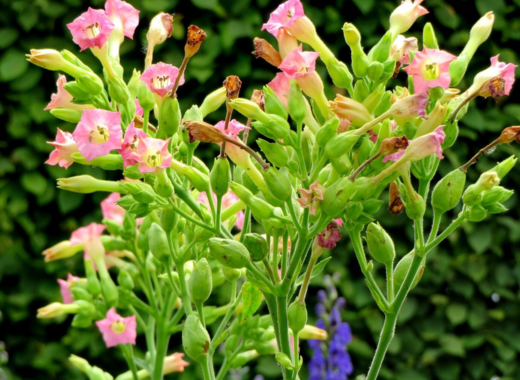Tobacco/ Tamra Parna/ Nicotiana tabacum Linn. – Ayurvedic Uses, Benefits, Dosage & Therapeutic Actions
Abstract
Nicotiana tabacum Linn., commonly known as cultivated tobacco, is a significant plant both economically and medicinally, despite its notorious association with harmful smoking habits. Traditionally, various parts of the plant have been utilised in folk medicine for external applications, owing to their antimicrobial, analgesic, and insecticidal properties. The leaves are rich in alkaloids, primarily nicotine, which plays a role in its pharmacological as well as toxicological actions. In Ayurveda and traditional practices, the plant finds mention for its use in wound healing, dental care, and pest control. But nowadays, it has been used by people as an addiction, and its excessive use can cause cancer. This plant is native to America and was introduced in India by the Portuguese, hence, it is not described by other Nighantus. It is first described in Raj Nighantus. This article explores its taxonomy, morphology, habitat, properties, and therapeutic uses from an Ayurvedic perspective.

Introduction
Nicotiana tabacum is a perennial herbaceous plant belonging to the Solanaceae family, widely cultivated for its leaves. Though its primary use today is in tobacco products, historical records suggest that it was employed in various indigenous medical systems for external therapies and fumigation. Ayurveda recognises its potential in specific conditions, provided it is used judiciously due to its potent alkaloid content. This plant is native to tropical America but has adapted to diverse climates worldwide. Understanding its therapeutic attributes alongside its risks allows for a balanced perspective on its applications in traditional medicine.
Scientific Classification
- Kingdom: Plantae
- Order: Solanales
- Family: Solanaceae
- Genus: Nicotiana
- Species: Nicotiana tabacum Linn.
Synonyms
- Gucchaphala – The fruits are found in clusters.
- Kalanj
- Tamala
- Dhumrapatra – Leaves are used for smoking
- Sulabha
- Gridhrapatra
- Dhumrahava
- Svayambhuva
- Krimighani – Helps in worm infestation
- Gridhrani
- Strimalapaha
Vernacular Names
- Arabic – Tobgh, Totan, Skair, Tabaaq, Tanbak, Tanbako
- Bengali – Tamaka
- Chinese – Yancao
- English – Tobacco
- French – Tabac, Tabac commun
- German – Tabak, Virginischer Tabak
- Gujarati – Tamaku
- Hindi – Bajr-bhang, Tambaku, Tumak
- Italian – Tobacco
- Japanese – Nikochianatabakamu, Tabako
- Kannada – Hogesoppu
- Korean – Dambae
- Malayalam – Pokal
- Marathi – Tambaku
- Persian – Bajr bhang, Tanbaku, Tutun, Tutuni Kurdistan
- Spanish – Tabaco
- Swedish – Virginiatobak
- Tamil – Poga Elai
- Telugu – Pogaku
- Turkish – Tutun
Habitat
Nicotiana tabacum is believed to have originated in tropical regions of South America, later spreading across the globe through cultivation. It thrives in warm, frost-free climates and prefers sandy loam soils with good drainage. It is extensively grown in countries like India, China, Brazil, and the United States, with India cultivating it predominantly in Gujarat, Andhra Pradesh, Karnataka, and Uttar Pradesh.
Morphology
Nicotiana tabacum is an erect, viscid, annual or short-lived perennial herb growing 0.7–3 m tall. The stout stem is hairy and sticky due to glandular trichomes. Leaves are large, cauline, oblong to broadly elliptic-ovate, 24–40 × 13–25 cm, sessile, and thin in texture, often cuneate or auricled at the base. Flowers are pink to rose-colored, tubular, and fragrant, borne in axillary and terminal compact corymboid panicles. The calyx is 10–12 mm long, oblong, and persistent, with unequal lobes, while the corolla tube is 3.5–4.6 cm long and glandular-hairy externally. The fruit is an oblong-ovoid capsule about 20 mm long, containing numerous minute, brown, angled, and minutely ruminate seeds.
Classical Categorisation
- Raj Nighantu Parpatadi Varga
Ayurvedic Properties
- Taste (Rasa) – Bitter (Tikta), Pungent (Katu)
- Physical Property (Guna) – Light (Laghu), Sharp (Teekshna), Penetrating/Diffusing (Vyavayi), Separating (Vikasi)
- Potency (Veerya) – Hot Potency (Usna)
- Post-digestion Effect (Vipaka) – Katu (Pungent)
- Effect on Tridosha – Balance Vata and Kapha dosha
- Effect (Prabhava) – Intoxicating (Madak)
Therapeutic Properties
- Ushna (hot in potency)
- Anthelmintic
- Antiinflammatory
- Appetiser
- Digestive stimulant
- Toothache
- Possible therapeutic role of nicotine in Alzheimer’s disease, Parkinson’s disease, depression, anxiety, schizophrenia, ADHD, pain, and obesity
Systemic Actions
External Use
Acts as an analgesic, anti-inflammatory, and anti-helminthic. The leaves are applied in cases of scrotal swelling, joint pain, and similar inflammatory conditions. They can be used as a tooth powder to help prevent tooth decay and also administered as Nasya in ailments of the Kapha–Vata type.
Internal Use
- Nervous System – Initially stimulates the nervous system, but prolonged use may lead to fatigue and lethargy.
- Digestive System – In small doses, it promotes the secretion of digestive enzymes, enhances intestinal motility, and facilitates the balanced movement of doshas. May cause nausea and vomiting in higher amounts.
- Circulatory System – At first, it slows circulation, but later can increase heart rate and lead to hypertension.
- Respiratory System – Reduces respiratory rate in small doses; excessive intake may result in respiratory distress.
- Excretory System – Enhances the secretion of ADH hormone, reducing urine output.
- Reproductive System – Potent uterine stimulant; may trigger abortion or preterm delivery.
- Satmikarana (Nourishment) – Overdose may lead to Ojo-kshaya and Dhatu-kshaya (loss of vitality and tissue depletion). Harmful to the eyes, reducing vision. Traditionally indicated in snakebite and strychnine poisoning. Excessive intake may cause sluggishness, insomnia, cough, weakness, anaemia, liver disorders, and vision loss.
Chemical Composition
1. Phytochemical Constituents (Leaves)
Sesquiterpenes, alkaloids, lignans, flavonoids, phenolic compounds, tannins, steroids, terpenoids, cardiac glycosides, essential oils, saponins, quinines, polypeptides, phenylpropanoids, chromanones, biphenyls, and isocoumarins.
2. Phytochemical Constituents (Stem)
Alkaloids, carbohydrates, saponins, phenols, flavonoids, tannins, phytosterols, and triterpenes.
3. Major Alkaloids In Leaves
Nicotine (4.19%), nicoteine, nicotyrine, nicotimine, nicotelline, isonicoteine, nornicotine, anabaine, anatalline, anabasine, anatabine, and myosmine.
4. Sesquiterpenes In Leaves
Nicotiana sesterpenes A and B, tabasesquiterpenes A–C, glutinosone, capsidiol, 1-β-hydroxy-α-cyperone, arundinol B, 3-hydroxy solavetivone-β-D-glucoside A and B, 14-noreudesmane sesquiterpenes.
5. Polyphenols
Dominant ones are chlorogenic acid and rutin.
6. Flavonoid And Polysaccharide Content In Leaves
Total flavonoids: 10.83 ± 0.91 mg rutin equivalent/g DW; total polysaccharides: 49.82 ± 3.42 mg/g DW (46.61 ± 3.11 mg/g neutral polysaccharides, 3.21 ± 0.22 mg/g acidic polysaccharides).
7. Phenolic Content In Leaves
Flavonoid fraction: 23.2 ± 1.31 mg gallic acid equivalent/g; polysaccharide fraction: 0.74 ± 0.04 mg GAE/g.
8. Flavonoid And Phenolic Content In Stem Extract
Total flavonoids: 12.5 ± 0.1322 mg QE/g extract; phenolics: 1133.25 ± 0.02 mg QE/g extract.
9. Phenolic Acids From Virus-Infected Leaves
Quinic esters (3-caffeoylquinic acid, 4-caffeoylquinic acid, 5-caffeoylquinic acid, 3-feruloylquinic acid, 4-feruloylquinic acid, 5-feruloylquinic acid, 3-p-coumaroylquinic acid); glucose esters (1-caffeoylglucose, 1-feruloylglucose, 1-o-coumaroylgentiobiose/neochlorogenic acid, 1-o-coumaroylglucose, melilotoside, melilotic acid glucoside); glycosides (vanillic acid glucoside, p-hydroxybenzoic acid glucoside, gentisic acid glucoside).
10. Coumarins
Scopolin (scopoletin 7-glucoside), cichoriin (esculetin 7-glucoside), scopoletin 7-gentiobioside.
11. Flavonols
Rutin (quercetin 3-rutinoside), nicotiflorin (kaempferol 3-rutinoside), isoquercitrin (quercetin 3-glucoside), quercetin-3,3-dimethyl ether, quercetin-3-methyl ether.
12. Essential Oil Constituents (Fresh Leaves)
Cyclohexane (8.43%), p-xylene (12.37%), 3-methyl-octane (0.88%), 1-ethyl-3-methylcyclohexane (2.59%), nonane (4.35%), 3,5-dimethyl-3-heptene (1.44%), (1-methylethyl)-cyclohexane (1.70%), propyl-cyclohexane (2.20%), 2,6-dimethyloctane (1.04%), propyl-benzene (1.64%), 1-ethyl-3-methylbenzene (2.19%), 1,3-dimethyl-2-cyclopentane (0.99%), octahydro-2,5-dimethyl-pentalene (1.80%), 1,2,3-trimethyl-benzene (8.73%), 1-methyl-2-propyl-cyclohexane (0.52%), decane (3.60%), 1,2,5-trimethyl-benzene (2.10%), 4-methyl-decane (1.02%), butyl-cyclohexane (0.76%), decahydronaphthalene (1.05%), 1-methyl-2-(1-methylethyl)-benzene (1.45%), E-2-tetradecaen-1-ol (1.00%), 1-ethyl-2,4-dimethylbenzene (0.80%), undecane (2.49%), 6,8-nonadien-2-one (2.63%), isocaryophyllene (0.54%), 2,6-dimethyl-heptadecane (0.52%), tridecanal (0.99%), 3,7,11,15-tetramethyl-2-hexadecen-1-ol (16.37%), thunbergol (1.78%), 9-dodecyltradecahydroanthracene (0.73%), farnesol (3.08%), 1-naphthalenepropanol (3.08%), docosane (1.34%), 9-methyl-nonadecane (2.97%).
13. Seed Composition
Lipids: 41.3%; hydrocarbons (1.4%), wax esters (1.7%), sterol esters (2.4%), triacylglycerols (69.3%), free fatty acids (6.2%).
Modern Overview
Cancerous Activity
Nicotine, the major alkaloid in Nicotiana tabacum, plays a crucial role in cancer promotion by influencing multiple cellular mechanisms. It binds to nicotinic acetylcholine receptors (nAChRs) present on lung and other cancer cells, stimulating abnormal cell proliferation and growth. Nicotine also induces resistance to apoptosis, allowing damaged cells to survive and accumulate, which contributes to tumour expansion. Another key mechanism is angiogenesis, where nicotine enhances the formation of new blood vessels, ensuring a constant supply of oxygen and nutrients to tumours. Beyond its direct effects, nicotine undergoes metabolic conversion during tobacco curing and smoking into highly carcinogenic tobacco-specific nitrosamines, including NNK (4-(Methylnitrosamino)-1-(3-pyridyl)-1-butanone) and NNAL (4-(Methylnitrosamino)-1-(3-pyridyl)-1-butanol). These nitrosamines directly damage DNA, cause genetic mutations, and act as strong cancer initiators. Nicotine and its derivatives also activate downstream signalling pathways through receptor-mediated mechanisms that favour tumour cell survival, invasion, and metastasis. Together, these processes illustrate how nicotine not only promotes but also sustains cancer development and progression.
Analgesic Effects (For Toothache)
Nicotine, the primary active alkaloid in Nicotiana tabacum, exerts its effects by stimulating nicotinic acetylcholine receptors in the nervous system. This activation triggers the release of various neurotransmitters, including dopamine, norepinephrine, and acetylcholine, which can influence pain perception and provide temporary analgesia. Nicotine may also modulate pain pathways in the brain and spinal cord, potentially reducing the sensation of pain and exhibiting mild anti-inflammatory effects. In traditional practices, tobacco leaves were sometimes applied locally to relieve a toothache, likely due to these pharmacological actions.
For Weight Loss
Nicotine, the primary chemical in Nicotiana tabacum (tobacco), can influence body weight through several mechanisms. It suppresses appetite by acting on the brain’s hunger centres, leading to reduced food intake, and also increases energy expenditure by stimulating the release of adrenaline, which boosts metabolism and calorie burning. Additionally, nicotine promotes thermogenesis (heat production) and enhances adipose lipolysis, breaking down fat stores to release energy. It may also alter fat distribution in the body, though this effect is not uniform. However, these weight-reducing actions are usually temporary, and many individuals experience weight gain after quitting smoking. Importantly, nicotine carries significant health risks, including strong addiction and damage to multiple organs, making it unsafe for weight management. Therefore, sustainable methods like a balanced diet, regular exercise, and lifestyle changes are far healthier and more effective alternatives.
Effect On The Circulatory System
Nicotine, the primary active compound in Nicotiana tabacum, affects the circulatory system by binding to nicotinic acetylcholine receptors (nAChRs), which triggers the release of catecholamines such as adrenaline. This leads to increased heart rate, elevated blood pressure, and heightened cardiac workload. Prolonged exposure can promote the development of atherosclerosis by damaging blood vessel walls and encouraging plaque buildup, as well as increasing the risk of thrombosis through enhanced platelet aggregation.
Practical Uses
- The dried tobacco leaf is gently warmed, applied, and tied over joints affected by pain and swelling to provide relief.
- The powdered dried leaf serves as an antidote for Strychnos nux vomica (Strychnine tree) poisoning.
- When the dried leaf is burned, its fumes, inhaled in small quantities, are traditionally used to relieve cough and manage snake bite poisoning by inducing vomiting.
- For dental pain due to caries, the dried leaf powder is applied directly to the affected tooth.
- To treat sinusitis and associated headaches, the powdered leaf is blown into the nostrils.
- In doses of 1–2 g, the dried leaf acts as a cardiac and nerve stimulant, proving beneficial in cases of depression.
Part Used
Dried leaf
Dosage
50–100 mg
Conclusion
Nicotiana tabacum, though widely criticised for its role in tobacco-related health hazards, holds a distinct place in traditional medicine for specific external therapeutic applications. Its strong antimicrobial and insecticidal properties make it valuable in wound care and pest control. However, due to its potent nicotine content, internal use is discouraged in Ayurveda except in controlled medicinal preparations. Awareness of both its benefits and risks ensures responsible utilisation of this powerful plant.



